Behavior and Performance of Reinforced Concrete Columns Subjected to Accelerated Corrosion
Abstract
1. Introduction
2. Corrosion Mechanism
2.1. Carbonation
2.2. Chloride Ions Attack
3. Effects of Corrosion
3.1. Cracking
3.2. Bond Strength
3.3. Mechanical Properties of Reinforcement
4. Methodology
4.1. Parametric Investigations
- Concrete strength;
- Cover to reinforcement diameter (c/D) ratio;
- Level of corrosion in days.
4.2. Behavioral Investigations of Corroded Columns
5. Specimen Preparation and Instrumentation
5.1. Reinforcement Caging, Electrical Wiring and Concrete Casting
5.2. Instrumentation and Accelerated Corrosion Setup
6. Testing Results and Discussions
6.1. Specimen Observations
6.1.1. Surface Cracking
6.1.2. Surface Pitting
6.2. Axial Compression Testing
6.3. Effect of Concrete Cover to Axial Load Carrying Capacity
6.3.1. 21 MPa Specimens
6.3.2. 28 MPa Specimens
6.4. Reinforcement Weight Loss
6.4.1. 21 MPa Specimens
6.4.2. 28 MPa Specimens
6.5. Effect of Corroded Column Length on Axial Load Capacity
7. Conclusions
- The concrete cover serves as the initial line of defense against corrosion of the reinforcement. A thicker concrete cover provides greater resistance against corrosion. The results demonstrated a 10% difference in percentage between column specimens with a cover of 30 mm and those with a cover of 20 mm.
- The column specimens that encounter corrosive and hostile environment exhibit a 10–20% decrease in axial control capacity. Out of this reduction, a corroded column with less concrete cover experiences a reduction of over 50% during the early stages of corrosion.
- The concrete strength also has a significant effect on the corrosion of specimens. The specimens with higher concrete strength exhibit less surface cracking and surface pitting, resulting in reduced corrosion. The experimental findings identified that when concrete strength was raised by 25%, column specimens’ axial capacities increased by 4%.
- The corrosion can have a substantial impact on the axial load capacity of the column specimens when they have small cover combined with reduced reinforcement area and increased length. The experimental results indicated a 25% reduction in the axial capacity when the column height was increased from 700 mm to 900 mm.
Author Contributions
Funding
Institutional Review Board Statement
Informed Consent Statement
Data Availability Statement
Acknowledgments
Conflicts of Interest
References
- Dixit, M.; Gupta, A.K. A Review of Different Assessment Methods of Corrosion of Steel Reinforcement in Concrete. Iran. J. Sci. Technol. Trans. Civ. Eng. 2022, 46, 735–752. [Google Scholar] [CrossRef]
- Poston, R.W.; West, J.S. Investigation of the Charlotte Motor Speedway Bridge Collapse. In Proceedings of the Structures Congress 2005: Metropolis and Beyond, New York, NY, USA, 20–24 April 2005; pp. 1–11. [Google Scholar]
- Hameed, A.; Rasool, A.M.; Ibrahim, Y.E.; Afzal, M.F.U.D.; Qazi, A.U.; Hameed, I. Utilization of Fly Ash as a Viscosity-Modifying Agent to Produce Cost-Effective, Self-Compacting Concrete: A Sustainable Solution. Sustainability 2022, 14, 11559. [Google Scholar] [CrossRef]
- Ortiz, J.D.; Dolati, S.S.K.; Malla, P.; Nanni, A.; Mehrabi, A. FRP-Reinforced/Strengthened Concrete: State-of-the-Art Review on Durability and Mechanical Effects. Materials 2023, 16, 1990. [Google Scholar] [CrossRef] [PubMed]
- Khodayari, A.; Mantawy, I.M.; Azizinamini, A. Experimental and Numerical Investigation of Prefabricated Concrete Barrier Systems Using Ultra-High-Performance Concrete. Transp. Res. Rec. J. Transp. Res. Board 2023, 036119812311625. [Google Scholar] [CrossRef]
- Saingam, P.; Ejaz, A.; Ali, N.; Nawaz, A.; Hussain, Q.; Joyklad, P. Prediction of Stress–Strain Curves for HFRP Composite Confined Brick Aggregate Concrete under Axial Load. Polymers 2023, 15, 844. [Google Scholar] [CrossRef]
- Malla, P.; Dolati, S.S.K.; Ortiz, J.D.; Mehrabi, A.B.; Nanni, A.; Dinh, K. Feasibility of Conventional Non-Destructive Testing Methods in Detecting Embedded FRP Reinforcements. Appl. Sci. 2023, 13, 4399. [Google Scholar] [CrossRef]
- Ebell, G.; Burkert, A.; Fischer, J.; Lehmann, J.; Müller, T.; Meinel, D.; Paetsch, O. Investigation of chloride-induced pitting corrosion of steel in concrete with innovative methods. Mater. Corros. 2016, 67, 583–590. [Google Scholar] [CrossRef]
- Javed, A.; Krishna, C.; Ali, K.; Afzal, M.F.U.D.; Mehrabi, A.; Meguro, K. Micro-Scale Experimental Approach for the Seismic Performance Evaluation of RC Frames with Improper Lap Splices. Infrastructures 2023, 8, 56. [Google Scholar] [CrossRef]
- Ejaz, A.; Ruangrassamee, A.; Kruavit, P.; Udomworarat, P.; Wijeyewickrema, A.C. Strengthening of substandard lap splices using hollow steel section (HSS) collars. Structures 2022, 46, 128–145. [Google Scholar] [CrossRef]
- Basit, S.; Maki, T.; Mutsuyoshi, H.; Ishihara, Y.; Tajima, H. Influence of reinforcement arrangement details on mechanical behavior of precast concrete barrier with loop connection. Structures 2020, 27, 1682–1692. [Google Scholar] [CrossRef]
- Afzal, M.F.U.D.; Matsumoto, Y.; Nohmi, H.; Sakai, S.; Su, D.; Nagayama, T. Comparison of Radar Based Displacement Measurement Systems with Conven-tional Systems in Vibration Measurements at a Cable Stayed Bridge. In Proceedings of the 11th German-Japan Bridge Symposium, Osaka, Japan, 30–31 August 2016; Available online: https://www.researchgate.net/publication/307932143 (accessed on 26 April 2023).
- Awan, M.S.; Javed, A.; Afzal, M.F.U.D.; Vilchez, L.F.N.; Mehrabi, A. Evaluation of System Identification Methods for Free Vibration Flutter Derivatives of Long-Span Bridges. Appl. Sci. 2023, 13, 4672. [Google Scholar] [CrossRef]
- Mustafa, A.E.; Javed, A.; Ali, K. Safety Assessment of Cables of Suspension Bridge under Blast Load. In Proceedings of the Structures Congress 2022, Atlanta, GA, USA, 20–23 April 2022; pp. 79–93. [Google Scholar] [CrossRef]
- Ali, K.; Javed, A.; Mustafa, A.E.; Saleem, A. Blast-Loading Effects on Structural Redundancy of Long-Span Suspension Bridge Using a Simplified Approach. Pract. Period. Struct. Des. Constr. 2022, 27, 04022024. [Google Scholar] [CrossRef]
- Ashraf, S.; Ali, M.; Shrestha, S.; Hafeez, M.A.; Moiz, A.; Sheikh, Z.A. Impacts of climate and land-use change on groundwater recharge in the semi-arid lower Ravi River basin, Pakistan. Groundw. Sustain. Dev. 2022, 17, 100743. [Google Scholar] [CrossRef]
- Javed, A.; Sadeghnejad, A.; Yakel, A.; Azizinamini, A. Magnetic Flux Leakage (MFL) Method for Damage Detection in Internal Post-Tensioning Tendons. 2021. Available online: https://rosap.ntl.bts.gov/view/dot/62244 (accessed on 27 April 2023).
- Javed, A.; Mantawy, I.M.; Azizinamini, A. 3D-Printing of Ultra-High-Performance Concrete for Robotic Bridge Construction. Transp. Res. Rec. J. Transp. Res. Board 2021, 2675, 307–319. [Google Scholar] [CrossRef]
- Lu, Y.-Y.; Hu, J.-Y.; Li, S.; Tang, W.-S. Active and passive protection of steel reinforcement in concrete column using carbon fibre reinforced polymer against corrosion. Electrochim. Acta 2018, 278, 124–136. [Google Scholar] [CrossRef]
- Meda, A.; Mostosi, S.; Rinaldi, Z.; Riva, P. Experimental evaluation of the corrosion influence on the cyclic behaviour of RC columns. Eng. Struct. 2014, 76, 112–123. [Google Scholar] [CrossRef]
- Xu, J.-G.; Cai, Z.-K.; Feng, D.-C. Life-cycle seismic performance assessment of aging RC bridges considering multi-failure modes of bridge columns. Eng. Struct. 2021, 244, 112818. [Google Scholar] [CrossRef]
- Ma, Y.; Che, Y.; Gong, J. Behavior of corrosion damaged circular reinforced concrete columns under cyclic loading. Constr. Build. Mater. 2012, 29, 548–556. [Google Scholar] [CrossRef]
- Xu, J.-G.; Feng, D.-C.; Wu, G.; Cotsovos, D.M.; Lu, Y. Analytical modeling of corroded RC columns considering flexure-shear interaction for seismic performance assessment. Bull. Earthq. Eng. 2019, 18, 2165–2190. [Google Scholar] [CrossRef]
- Misra, S.; Uomoto, T. Behavior of Concrete Beams and Columns in Marine Environment When Corrosion of Reinforcing Bars Takes Place. Spec. Publ. 1988, 109, 127–146. [Google Scholar]
- Rodriguez, J.; Ortega, L.M.; Casal, J.; Arenas, D.J.M. Load Bearing Capacity of Concrete Columns with Corroded Reinforcement. In Proceedings of the Fourth International Symposium, Cambridge, UK, 1–4 July 1996. [Google Scholar]
- Azad, A.K.; Al-Osta, M.A. Capacity of Corrosion-Damaged Eccentrically Loaded Reinforced Concrete Columns. ACI Mater. J. 2014, 111, 711–722. [Google Scholar] [CrossRef]
- Broomfield, J.G. Corrosion of Steel in Concrete: Understanding, Repair and Investigation; CRC Press: Boca Raton, FL, USA, 1997. [Google Scholar]
- Yuvaraj, S.; Nirmalkumar, K.; Kumar, V.R.; Gayathri, R.; Mukilan, K.; Shubikksha, S. Influence of corrosion inhibitors in reinforced concrete—A state of art of review. Mater. Today Proc. 2022, 68, 2406–2412. [Google Scholar] [CrossRef]
- Liu, Y.; Hao, H.; Hao, Y. Blast fragility analysis of RC columns considering chloride-induced corrosion of steel reinforcement. Struct. Saf. 2022, 96, 102200. [Google Scholar] [CrossRef]
- Zhou, Y.; Gencturk, B.; Willam, K.; Attar, A. Carbonation-Induced and Chloride-Induced Corrosion in Reinforced Concrete Structures. J. Mater. Civ. Eng. 2015, 27, 04014245. [Google Scholar] [CrossRef]
- Vu, N.S.; Yu, B.; Li, B. Prediction of strength and drift capacity of corroded reinforced concrete columns. Constr. Build. Mater. 2016, 115, 304–318. [Google Scholar] [CrossRef]
- Soltani, A.; Nasserasadi, K.; Ahmadi, J.; Tafakori, E. Empirical assessment and refinement of corrosion distribution models in the perimeter of corroded steel rebar subjected to chloride ions attack. Case Stud. Constr. Mater. 2022, 17, e01398. [Google Scholar] [CrossRef]
- Han, L.-H.; Hou, C.-C.; Wang, Q.-L. Behavior of circular CFST stub columns under sustained load and chloride corrosion. J. Constr. Steel Res. 2014, 103, 23–36. [Google Scholar] [CrossRef]
- Alonso, C.; Andradel, C.; Rodriguez, J.; Diez, J.M. Factors controlling cracking of concrete affected by reinforcement corrosion. Mater. Struct. 1998, 31, 435–441. [Google Scholar] [CrossRef]
- Chernin, L.; Val, D.V.; Volokh, K.Y. Analytical modelling of concrete cover cracking caused by corrosion of reinforcement. Mater. Struct. 2009, 43, 543–556. [Google Scholar] [CrossRef]
- Guzmán, S.; Gálvez, J.C.; Sancho, J.M. Cover cracking of reinforced concrete due to rebar corrosion induced by chloride penetration. Cem. Concr. Res. 2011, 41, 893–902. [Google Scholar] [CrossRef]
- Bossio, A.; Monetta, T.; Bellucci, F.; Lignola, G.P.; Prota, A. Modeling of concrete cracking due to corrosion process of reinforcement bars. Cem. Concr. Res. 2015, 71, 78–92. [Google Scholar] [CrossRef]
- Cabrera, J. Deterioration of Concrete Due to Reinforcement Steel Corrosion. Cem. Concr. Compos. 1996, 18, 47–59. [Google Scholar] [CrossRef]
- Choi, Y.S.; Yi, S.-T.; Kim, M.Y.; Jung, W.Y.; Yang, E.I. Effect of corrosion method of the reinforcing bar on bond characteristics in reinforced concrete specimens. Constr. Build. Mater. 2014, 54, 180–189. [Google Scholar] [CrossRef]
- Al-Sulaimani, G.J.; Kaleemullah, M.; Basunbul, I.A.; Rasheeduzzafar. Influence of Corrosion and Cracking on Bond Behavior and Strength of Reinforced Concrete Members. Struct. J. 1990, 87, 220–231. [Google Scholar]
- Ma, Y.; Guo, Z.; Wang, L.; Zhang, J. Experimental investigation of corrosion effect on bond behavior between reinforcing bar and concrete. Constr. Build. Mater. 2017, 152, 240–249. [Google Scholar] [CrossRef]
- Saifullah, M. Effect of Reinforced Corrosion on Bond Strength in Reinforced Concrete. Doctoral Dissertation, The University of Birmingham, Birmingham, UK, 1994. [Google Scholar]
- Fang, C.; Lundgren, K.; Plos, M.; Gylltoft, K. Bond behaviour of corroded reinforcing steel bars in concrete. Cem. Concr. Res. 2006, 36, 1931–1938. [Google Scholar] [CrossRef]
- Hua, J.; Fan, H.; Xue, X.; Wang, F.; Chen, Z.; Huang, L.; Wang, N. Tensile and low-cycle fatigue performance of bimetallic steel bars with corrosion. J. Build. Eng. 2021, 43, 103188. [Google Scholar] [CrossRef]
- Hua, J.; Wang, F.; Huang, L.; Wang, N.; Xue, X. Experimental study on mechanical properties of corroded stainless-clad bimetallic steel bars. Constr. Build. Mater. 2021, 287, 123019. [Google Scholar] [CrossRef]
- Hua, J.; Wang, F.; Wang, N.; Huang, L.; Hai, L.; Li, Y.; Zhu, X.; Xue, X. Experimental and numerical investigations on corroded stainless-clad bimetallic steel bar with artificial damage. J. Build. Eng. 2021, 44, 102779. [Google Scholar] [CrossRef]
- François, R.; Khan, I.; Dang, V.H. Impact of corrosion on mechanical properties of steel embedded in 27-year-old corroded reinforced concrete beams. Mater. Struct. 2012, 46, 899–910. [Google Scholar] [CrossRef]
- Apostolopoulos, C.A. The Influence of Corrosion and Cross-Section Diameter on the Mechanical Properties of B500c Steel. J. Mater. Eng. Perform. 2008, 18, 190–195. [Google Scholar] [CrossRef]
- Arockiasamy, M.; Arvan, P.A. Behavior, Performance, and Evaluation of Prestressed Concrete/Steel Pipe/Steel H-Pile to Pile Cap Connections. Pract. Period. Struct. Des. Constr. 2022, 27, 03122001. [Google Scholar] [CrossRef]
- Arvan, P.A.; Arockiasamy, M. Energy-Based Approach: Analysis of a Laterally Loaded Pile in Multi-Layered Non-Linear Elastic Soil Strata. Geotechnics 2022, 2, 570–598. [Google Scholar] [CrossRef]
- Zhang, W.; Chen, J.; Luo, X. Effects of impressed current density on corrosion induced cracking of concrete cover. Constr. Build. Mater. 2019, 204, 213–223. [Google Scholar] [CrossRef]
- Ha, T.-H.; Muralidharan, S.; Bae, J.-H.; Ha, Y.-C.; Lee, H.-G.; Park, K.-W.; Kim, D.-K. Accelerated short-term techniques to evaluate the corrosion performance of steel in fly ash blended concrete. Build. Environ. 2007, 42, 78–85. [Google Scholar] [CrossRef]
- Yuan, Y.; Ji, Y.; Shah, S.P. Comparison of two accelerated corrosion techniques for concrete structures. ACI Struct. J. 2007, 104, 344–347. [Google Scholar]
- Husain, A.; Al-Bahar, S.; Salam, S.A.; Al-Shamali, O. Accelerated AC impedance testing for prequalification of marine construction materials. Desalination 2004, 165, 377–384. [Google Scholar] [CrossRef]
- Geng, C.; Xu, Y.; Weng, D. A new method to quickly assess the inhibitor efficiency. J. Wuhan Univ. Technol. Sci. Ed. 2008, 23, 950–954. [Google Scholar] [CrossRef]
- YuBun, A.; Balaguru, P.; Chung, L. Bond Behavior of Corroded Reinforcement Bars. ACI Mater. J. 2000, 97, 214–220. [Google Scholar]
- Caré, S.; Raharinaivo, A. Influence of impressed current on the initiation of damage in reinforced mortar due to corrosion of embedded steel. Cem. Concr. Res. 2007, 37, 1598–1612. [Google Scholar] [CrossRef]
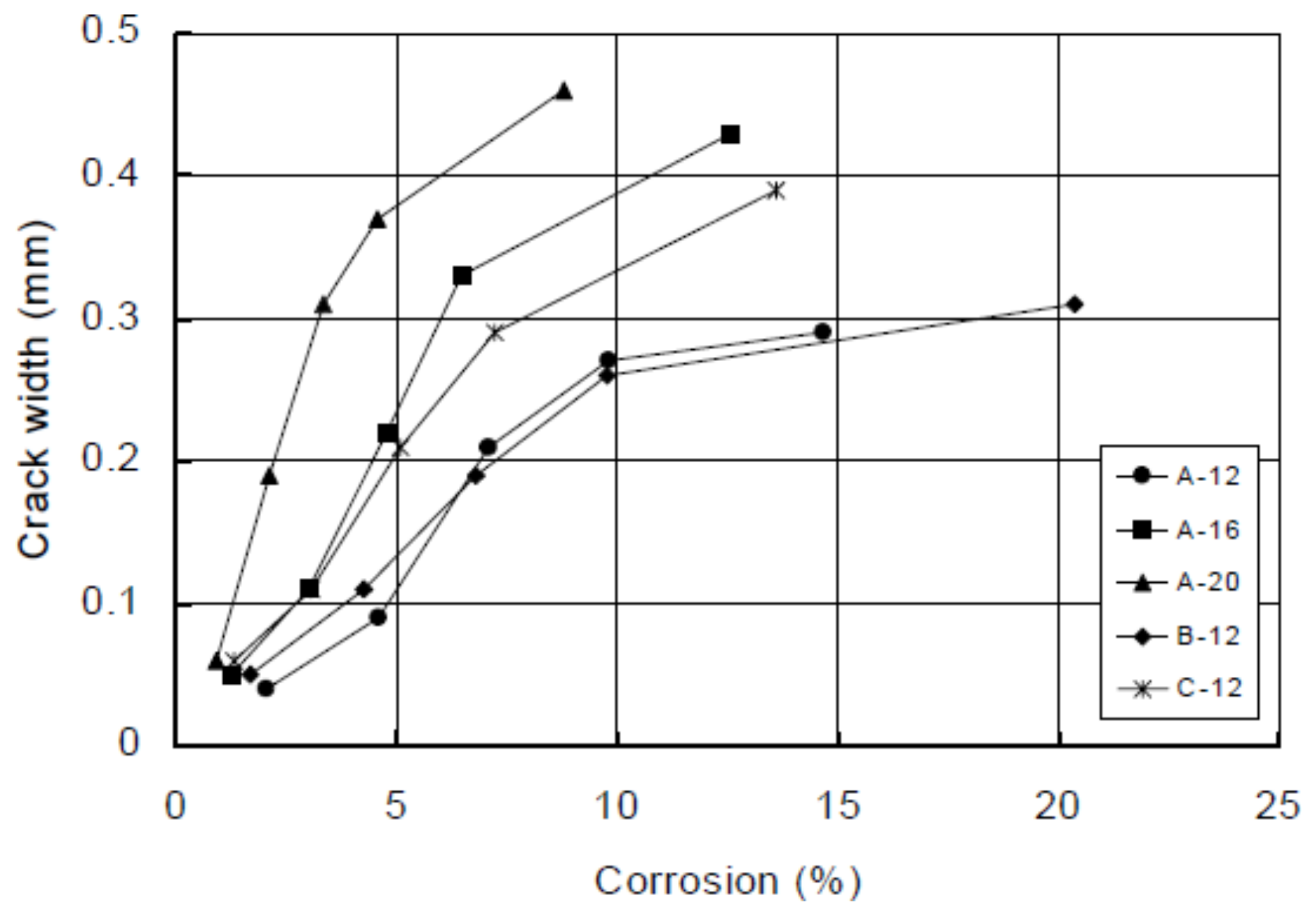

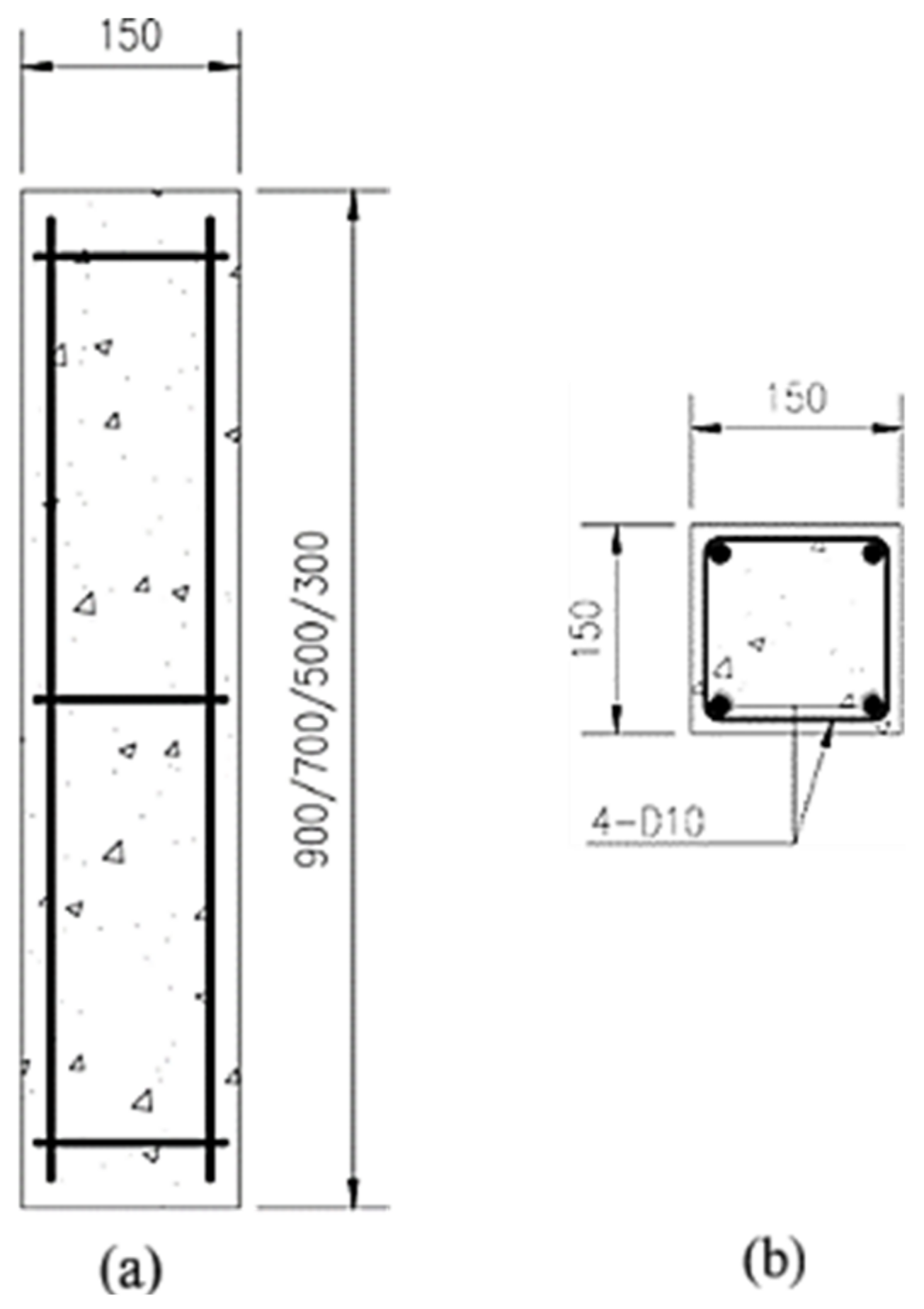


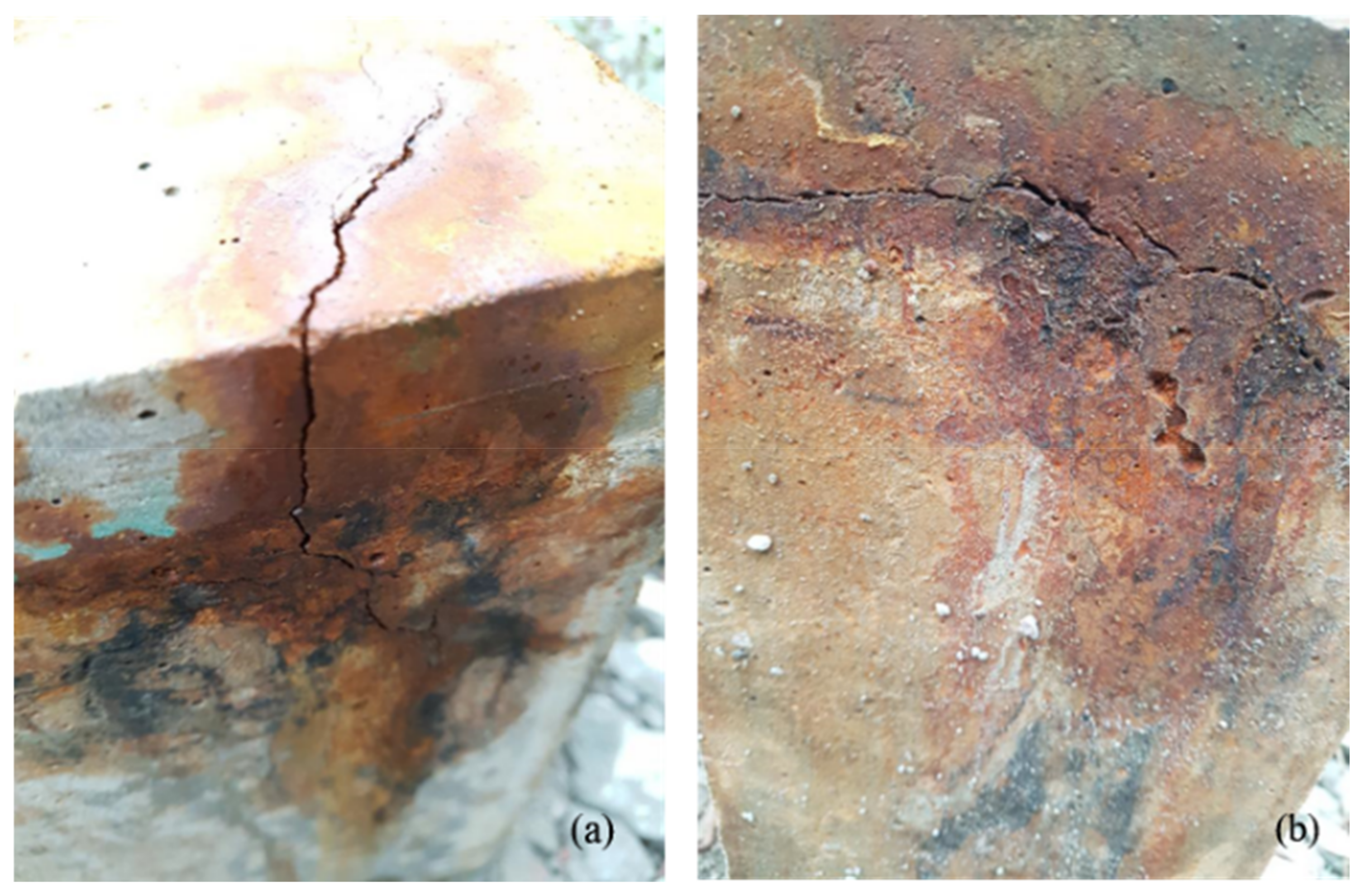
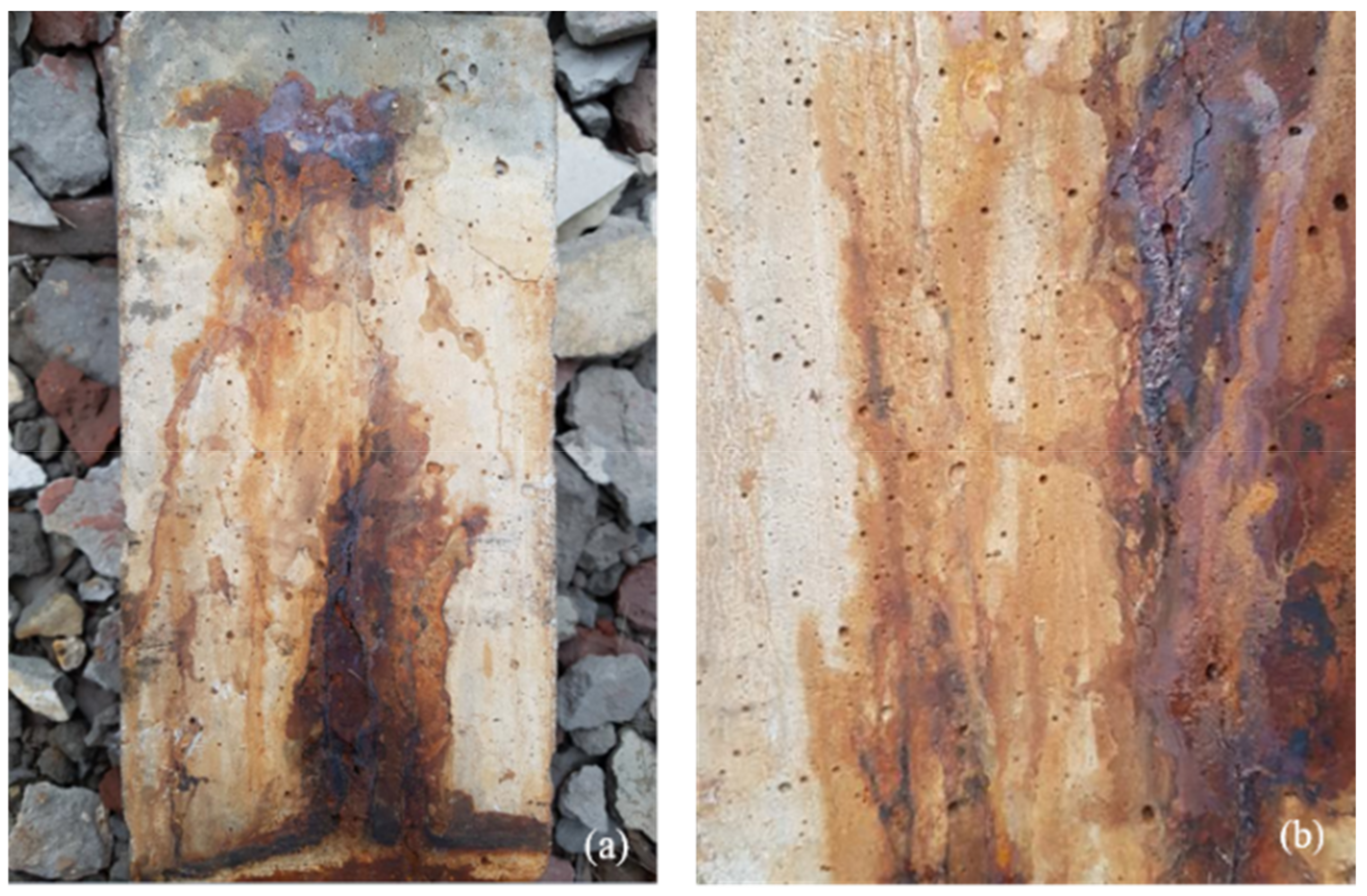




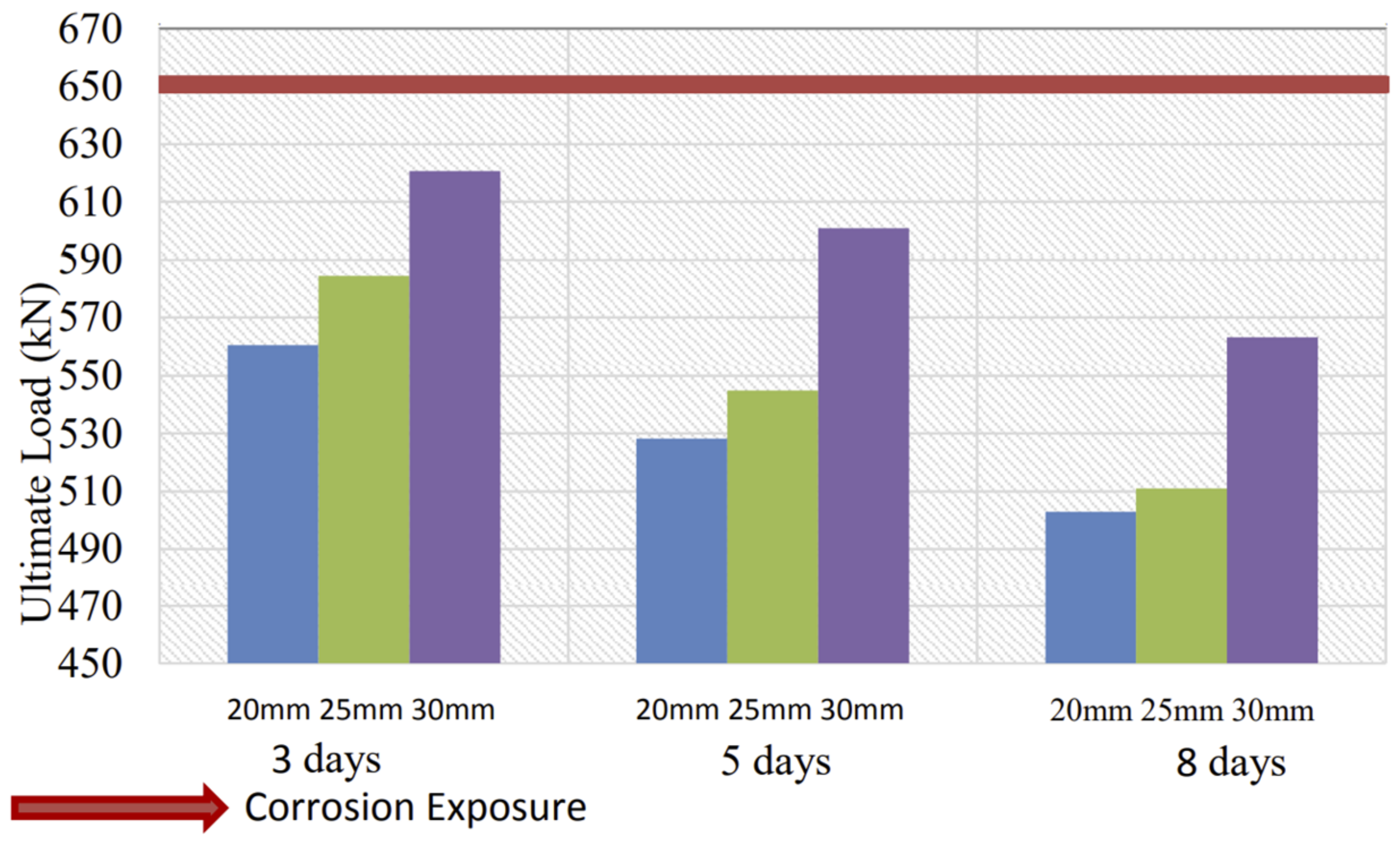
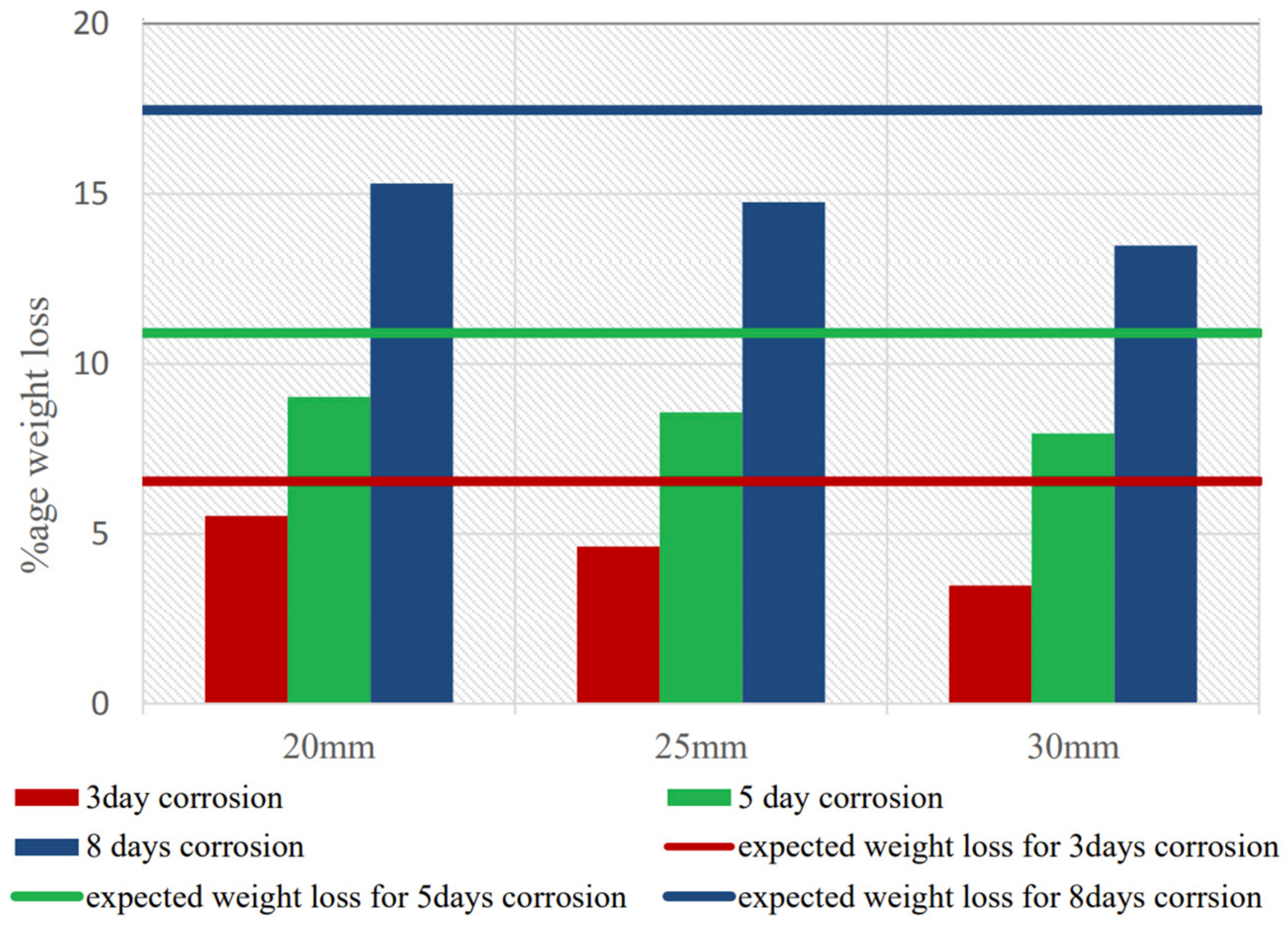
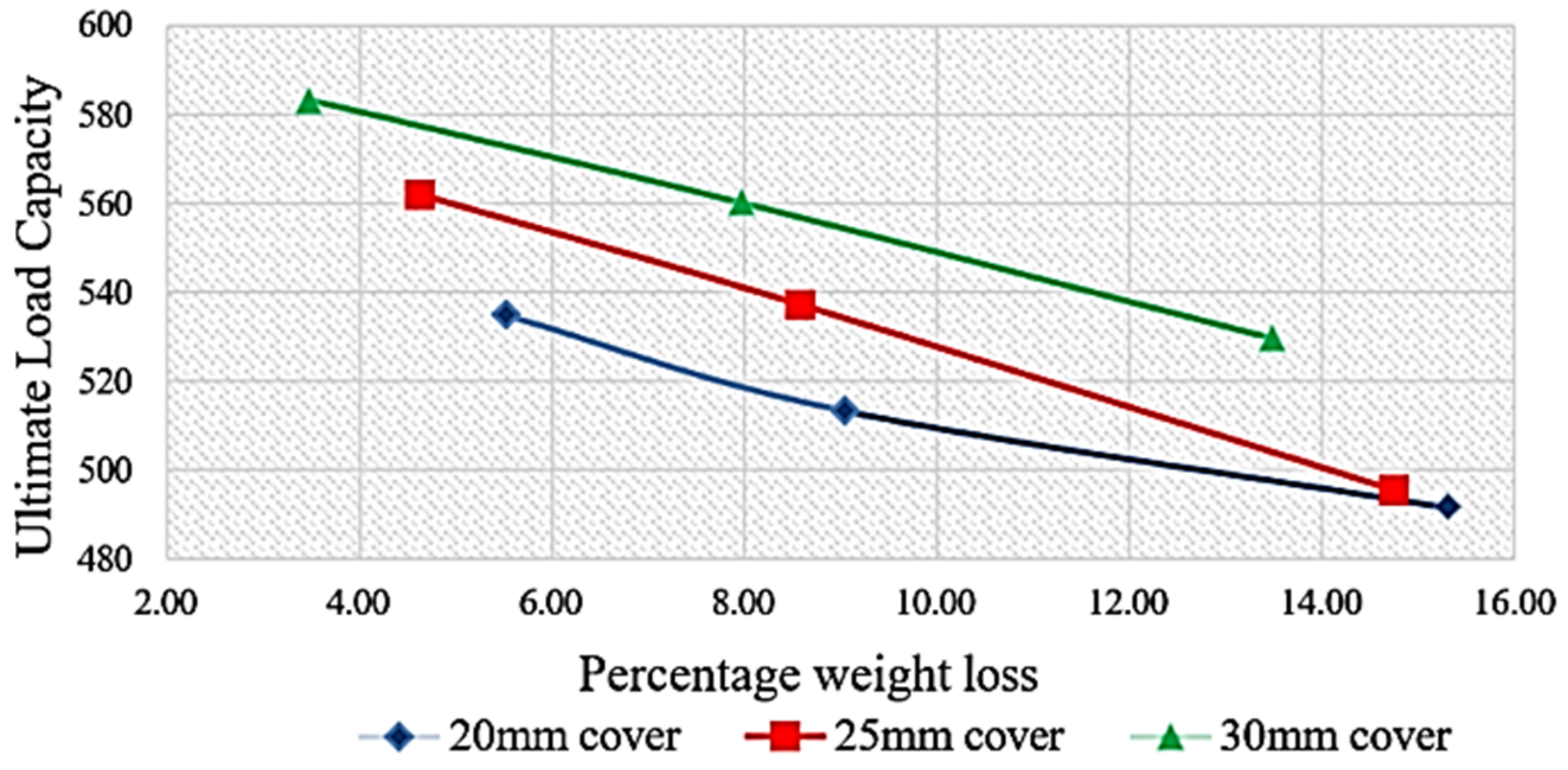
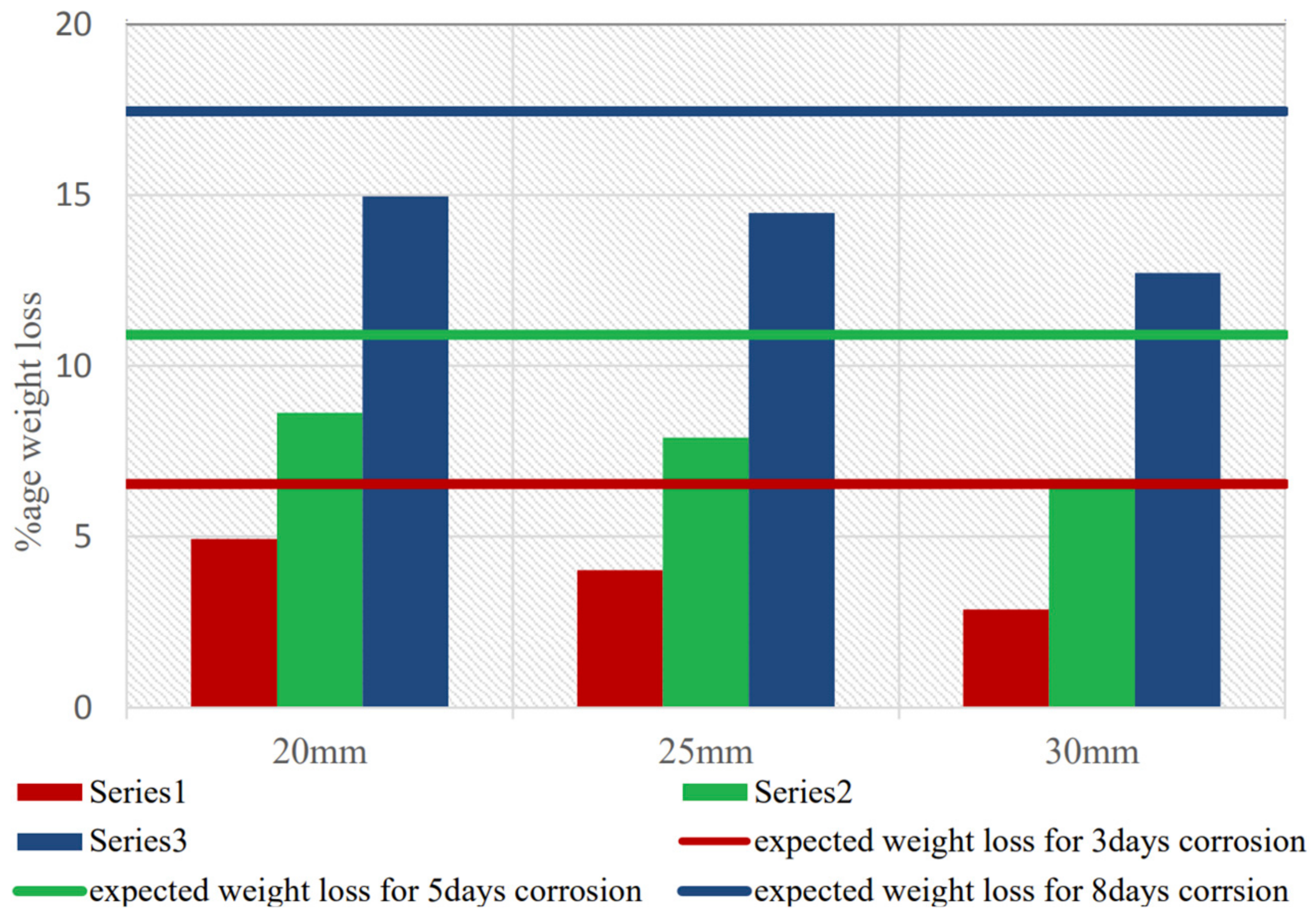
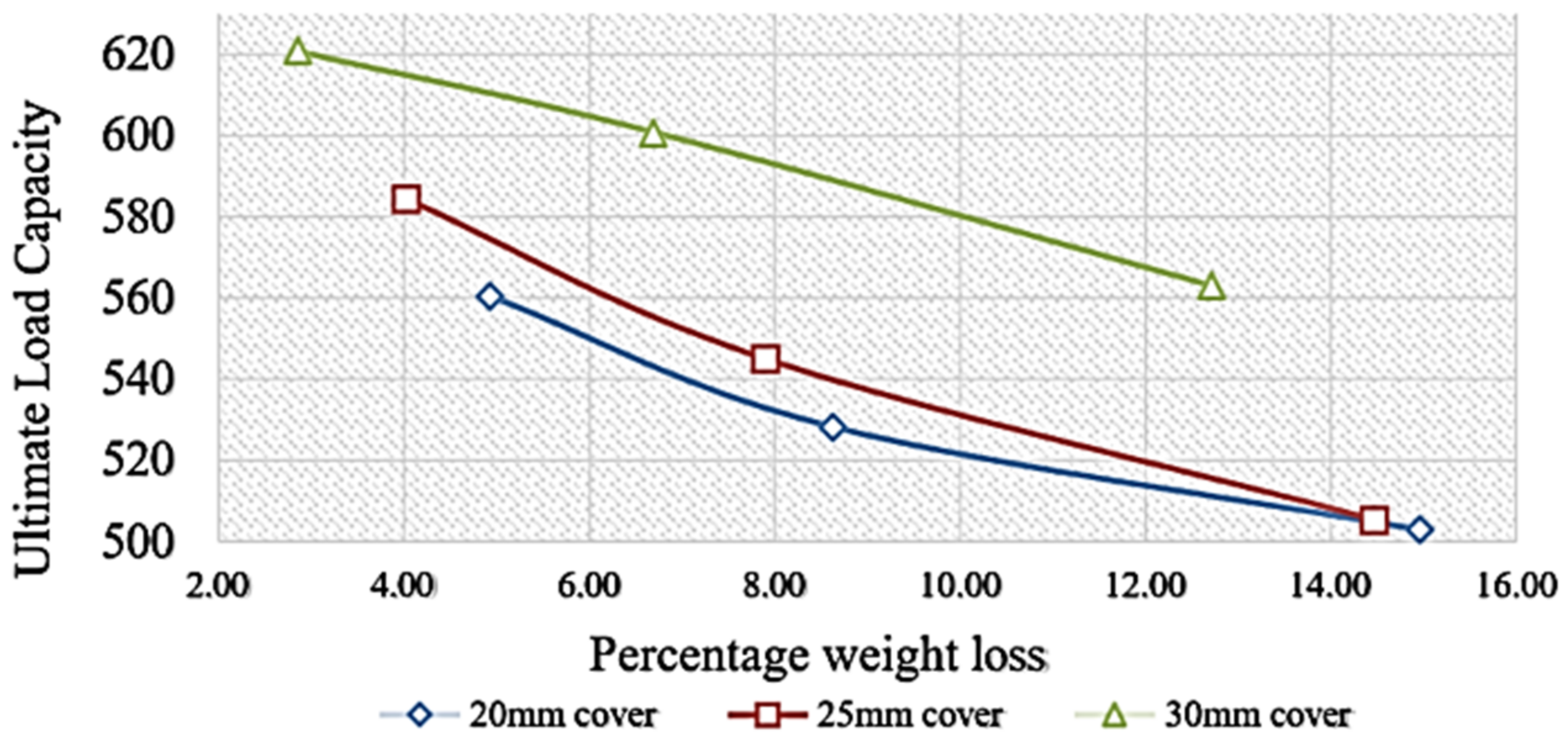

| Sample No. | Cement | Fine Aggregate | Coarse Aggregate | Mix Proportion | Target Strength (MPa) | w/c Ratio |
|---|---|---|---|---|---|---|
| 1 | 1.0 | 1.74 | 3.40 | 1:1.74:3.4 | 21 | 0.55 |
| 2 | 1.0 | 1.75 | 3.00 | 1:1.75:3 | 28 | 0.47 |
| Sr. No. | Specimen Type | Specimen Length (mm) | Concrete Strength (MPa) | Strength Designation | Concrete Cover | Cover Designation | Corrosion Exposure (Days) | Specimen Designation | No. of Specimens |
|---|---|---|---|---|---|---|---|---|---|
| 1 | R1 | 300 | 21 | A | 20 | X | - | R1AX-C | 3 |
| 2 | R1 | 300 | 21 | A | 25 | Y | - | R1AY-C | 3 |
| 3 | R1 | 300 | 21 | A | 30 | Z | - | R1AZ-C | 3 |
| 4 | R1 | 300 | 28 | B | 20 | X | - | R1BX-C | 3 |
| 5 | R1 | 300 | 28 | B | 25 | Y | - | R1BY-C | 3 |
| 6 | R1 | 300 | 28 | B | 30 | Z | - | R1BZ-C | 3 |
| 7 | R1 | 300 | 21 | A | 20 | X | 3 | R1AX-3 | 3 |
| 8 | R1 | 300 | 21 | A | 20 | X | 5 | R1AX-5 | 3 |
| 9 | R1 | 300 | 21 | A | 20 | X | 8 | R1AX-8 | 3 |
| 10 | R1 | 300 | 21 | A | 25 | Y | 3 | R1AY-3 | 3 |
| 11 | R1 | 300 | 21 | A | 25 | Y | 5 | R1AY-5 | 3 |
| 12 | R1 | 300 | 21 | A | 25 | Y | 8 | R1AY-8 | 3 |
| 13 | R1 | 300 | 21 | A | 30 | Z | 3 | R1AZ-3 | 3 |
| 14 | R1 | 300 | 21 | A | 30 | Z | 5 | R1AZ-5 | 3 |
| 15 | R1 | 300 | 21 | A | 30 | Z | 8 | R1AZ-8 | 3 |
| 16 | R1 | 300 | 28 | B | 20 | X | 3 | R1BX-3 | 3 |
| 17 | R1 | 300 | 28 | B | 20 | X | 5 | R1BX-5 | 3 |
| 18 | R1 | 300 | 28 | B | 20 | X | 8 | R1BX-8 | 3 |
| 19 | R1 | 300 | 28 | B | 25 | Y | 3 | R1BY-3 | 3 |
| 20 | R1 | 300 | 28 | B | 25 | Y | 5 | R1BY-5 | 3 |
| 21 | R1 | 300 | 28 | B | 25 | Y | 8 | R1BY-8 | 3 |
| 22 | R1 | 300 | 28 | B | 30 | Z | 3 | R1BZ-3 | 3 |
| 23 | R1 | 300 | 28 | B | 30 | Z | 5 | R1BZ-5 | 3 |
| 24 | R1 | 300 | 28 | B | 30 | Z | 8 | R1BZ-8 | 3 |
| 25 | R2 | 500 | 21 | A | 25 | Y | 5 | R2AY-5 | 3 |
| 26 | R3 | 700 | 21 | A | 25 | Y | 5 | R3AY-5 | 3 |
| 27 | R4 | 900 | 21 | A | 25 | Y | 5 | R4AY-5 | 3 |
| 28 | R2 | 500 | 21 | A | 25 | Y | - | R2AY-C | 3 |
| 29 | R3 | 700 | 21 | A | 25 | Y | - | R3AY-C | 3 |
| 30 | R4 | 900 | 21 | A | 25 | Y | - | R4AY-C | 3 |
| Specimen Designation | Concrete Strength (MPa) | Concrete Cover (mm) | Corrosion Exposure (days) | Ultimate Strength (KN) |
|---|---|---|---|---|
| R1AX-3 | 21 | 20 | 3 | 539.55 |
| R1AX-3 | 21 | 20 | 3 | 529.74 |
| R1AX-3 | 21 | 20 | 3 | 535.36 |
| R1AX-5 | 21 | 20 | 5 | 519.93 |
| R1AX-5 | 21 | 20 | 5 | 519.93 |
| R1AX-5 | 21 | 20 | 5 | 500.31 |
| R1AX-8 | 21 | 20 | 8 | 490.5 |
| R1AX-8 | 21 | 20 | 8 | 488.69 |
| R1AX-8 | 21 | 20 | 8 | 495.405 |
| R1AX-C | 21 | 20 | Control | 607.46 |
| R1AX-C | 21 | 20 | Control | 619.6 |
| R1AY-3 | 21 | 25 | 3 | 557.36 |
| R1AY-3 | 21 | 25 | 3 | 561.36 |
| R1AY-3 | 21 | 25 | 3 | 567.55 |
| R1AY-5 | 21 | 25 | 5 | 541.93 |
| R1AY-5 | 21 | 25 | 5 | 532.74 |
| R1AY-5 | 21 | 25 | 5 | 537.12 |
| R1AY-8 | 21 | 25 | 8 | 501.34 |
| R1AY-8 | 21 | 25 | 8 | 495.69 |
| R1AY-8 | 21 | 25 | 8 | 489.5 |
| R1AY-C | 21 | 25 | Control | 612.13 |
| R1AY-C | 21 | 25 | Control | 618.08 |
| R1AZ-3 | 21 | 30 | 3 | 585.6 |
| R1AZ-3 | 21 | 30 | 3 | 589.41 |
| R1AZ-3 | 21 | 30 | 3 | 575.17 |
| R1AZ-5 | 21 | 30 | 5 | 559.17 |
| R1AZ-5 | 21 | 30 | 5 | 556.36 |
| R1AZ-5 | 21 | 30 | 5 | 565.31 |
| R1AZ-8 | 21 | 30 | 8 | 529.74 |
| R1AZ-8 | 21 | 30 | 8 | 519.93 |
| R1AZ-8 | 21 | 30 | 8 | 539.55 |
| R1AZ-C | 21 | 30 | Control | 620.37 |
| R1AZ-C | 21 | 30 | Control | 612.7 |
| Specimen Designation | Concrete Strength (MPa) | Concrete Cover (mm) | Corrosion Exposure (Days) | Ultimate Strength (KN) |
|---|---|---|---|---|
| R1BX-3 | 28 | 20 | 3 | 562.79 |
| R1BX-3 | 28 | 20 | 3 | 568.98 |
| R1BX-3 | 28 | 20 | 3 | 549.36 |
| R1BX-5 | 28 | 20 | 5 | 529.74 |
| R1BX-5 | 28 | 20 | 5 | 535.12 |
| R1BX-5 | 28 | 20 | 5 | 519.93 |
| R1BX-8 | 28 | 20 | 8 | 500.31 |
| R1BX-8 | 28 | 20 | 8 | 507.93 |
| R1BX-8 | 28 | 20 | 8 | 500.31 |
| R1BX-C | 28 | 20 | Control | 641.04 |
| R1BX-C | 28 | 20 | Control | 655.52 |
| R1BY-3 | 28 | 25 | 3 | 583.17 |
| R1BY-3 | 28 | 25 | 3 | 588.6 |
| R1BY-3 | 28 | 25 | 3 | 581.17 |
| R1BY-5 | 28 | 25 | 5 | 549.36 |
| R1BY-5 | 28 | 25 | 5 | 545.93 |
| R1BY-5 | 28 | 25 | 5 | 539.55 |
| R1BY-8 | 28 | 25 | 8 | 510.12 |
| R1BY-8 | 28 | 25 | 8 | 507.31 |
| R1BY-8 | 28 | 25 | 8 | 498.5 |
| R1BY-C | 28 | 25 | Control | 647.55 |
| R1BY-C | 28 | 25 | Control | 657.55 |
| R1BZ-3 | 28 | 30 | 3 | 620.08 |
| R1BZ-3 | 28 | 30 | 3 | 612.32 |
| R1BZ-3 | 28 | 30 | 3 | 629.7 |
| R1BZ-5 | 28 | 30 | 5 | 595.27 |
| R1BZ-5 | 28 | 30 | 5 | 607.7 |
| R1BZ-5 | 28 | 30 | 5 | 599.65 |
| R1BZ-8 | 28 | 30 | 8 | 559.17 |
| R1BZ-8 | 28 | 30 | 8 | 568.6 |
| R1BZ-8 | 28 | 30 | 8 | 561.22 |
| R1BZ-C | 28 | 30 | Control | 658.93 |
| R1BZ-C | 28 | 30 | Control | 643.94 |
| Concrete Strength (MPa) | Concrete Cover (mm) | Corrosion Exposure (days) | Expected Weight Loss (Faraday’s Law) (g) | Weight before Corrosion (g) | Weight after Corrosion (g) | Percentage Loss (%) |
|---|---|---|---|---|---|---|
| 21 | 20 | 3 | 6.38 | 1500 | 1417 | 5.53 |
| 21 | 20 | 3 | 6.38 | 1505 | 1421 | 5.58 |
| 21 | 20 | 3 | 6.38 | 1486 | 1405 | 5.45 |
| 21 | 20 | 5 | 10.64 | 1565 | 1421 | 9.20 |
| 21 | 20 | 5 | 10.64 | 1550 | 1410 | 9.03 |
| 21 | 20 | 5 | 10.64 | 1567 | 1428 | 8.87 |
| 21 | 20 | 8 | 17.02 | 1499 | 1267 | 15.48 |
| 21 | 20 | 8 | 17.02 | 1540 | 1307 | 15.13 |
| 21 | 20 | 8 | 17.02 | 1476 | 1250 | 15.31 |
| 21 | 25 | 3 | 6.54 | 1475 | 1411 | 4.34 |
| 21 | 25 | 3 | 6.54 | 1480 | 1409 | 4.80 |
| 21 | 25 | 3 | 6.54 | 1584 | 1509 | 4.73 |
| 21 | 25 | 5 | 10.91 | 1603 | 1470 | 8.30 |
| 21 | 25 | 5 | 10.91 | 1690 | 1541 | 8.82 |
| 21 | 25 | 5 | 10.91 | 1590 | 1453 | 8.62 |
| 21 | 25 | 8 | 17.45 | 1601 | 1363 | 14.87 |
| 21 | 25 | 8 | 17.45 | 1569 | 1342 | 14.47 |
| 21 | 25 | 8 | 17.45 | 1589 | 1352 | 14.92 |
| 21 | 30 | 3 | 6.71 | 1315 | 1279 | 2.74 |
| 21 | 30 | 3 | 6.71 | 1407 | 1354 | 3.77 |
| 21 | 30 | 3 | 6.71 | 1479 | 1421 | 3.92 |
| 21 | 30 | 5 | 11.18 | 1414 | 1302 | 7.92 |
| 21 | 30 | 5 | 11.18 | 1561 | 1435 | 8.07 |
| 21 | 30 | 5 | 11.18 | 1344 | 1238 | 7.89 |
| 21 | 30 | 8 | 17.89 | 1483 | 1284 | 13.42 |
| 21 | 30 | 8 | 17.89 | 1408 | 1218 | 13.49 |
| 21 | 30 | 8 | 17.89 | 1463 | 1265 | 13.53 |
| Concrete Strength (MPa) | Concrete Cover (mm) | Corrosion Exposure (days) | Expected Weight Loss (Faraday’s Law) (g) | Weight before Corrosion (g) | Weight after Corrosion (g) | Percentage (%) |
|---|---|---|---|---|---|---|
| 28 | 20 | 3 | 6.38 | 1460 | 1389 | 4.86 |
| 28 | 20 | 3 | 6.38 | 1546 | 1468 | 5.05 |
| 28 | 20 | 3 | 6.38 | 1391 | 1323 | 4.89 |
| 28 | 20 | 5 | 10.64 | 1484 | 1354 | 8.76 |
| 28 | 20 | 5 | 10.64 | 1402 | 1281 | 8.63 |
| 28 | 20 | 5 | 10.64 | 1559 | 1427 | 8.47 |
| 28 | 20 | 8 | 17.02 | 1534 | 1301 | 15.19 |
| 28 | 20 | 8 | 17.02 | 1475 | 1253 | 15.05 |
| 28 | 20 | 8 | 17.02 | 1495 | 1276 | 14.65 |
| 28 | 25 | 3 | 6.54 | 1544 | 1481 | 4.08 |
| 28 | 25 | 3 | 6.54 | 1404 | 1345 | 4.20 |
| 28 | 25 | 3 | 6.54 | 1532 | 1474 | 3.79 |
| 28 | 25 | 5 | 10.91 | 1574 | 1449 | 7.94 |
| 28 | 25 | 5 | 10.91 | 1560 | 1443 | 7.50 |
| 28 | 25 | 5 | 10.91 | 1381 | 1267 | 8.25 |
| 28 | 25 | 8 | 17.45 | 1465 | 1259 | 14.06 |
| 28 | 25 | 8 | 17.45 | 1493 | 1284 | 14.00 |
| 28 | 25 | 8 | 17.45 | 1570 | 1329 | 15.35 |
| 28 | 30 | 3 | 6.71 | 1432 | 1396 | 2.51 |
| 28 | 30 | 3 | 6.71 | 1496 | 1451 | 3.01 |
| 28 | 30 | 3 | 6.71 | 1404 | 1361 | 3.06 |
| 28 | 30 | 5 | 11.18 | 1578 | 1473 | 6.65 |
| 28 | 30 | 5 | 11.18 | 1603 | 1501 | 6.36 |
| 28 | 30 | 5 | 11.18 | 1548 | 1439 | 7.04 |
| 28 | 30 | 8 | 17.89 | 1533 | 1334 | 12.98 |
| 28 | 30 | 8 | 17.89 | 1569 | 1379 | 12.11 |
| 28 | 30 | 8 | 17.89 | 1552 | 1349 | 13.08 |
| Specimen Length (mm) | Sample Designation | Ultimate Load (KN) | Expected Weight Loss (Faraday’s Law) (g) | Weight before Corrosion (g) | Weight after Corrosion (g) | Percentage (%) |
|---|---|---|---|---|---|---|
| 500 | R2AY-5 | 492.462 | 6.78 | 1700 | 1631 | 4.06 |
| 500 | R2AY-51 | 476.766 | 6.78 | 1675 | 1605 | 4.18 |
| 500 | R2AY-52 | 441.45 | 6.78 | 1567 | 1493 | 4.72 |
| 500 | R2AY-C | 525.816 | NA | NA | NA | NA |
| 500 | R2AY-C | 547.398 | NA | NA | NA | NA |
| 700 | R3AY-5 | 397.305 | 5.35 | 2150 | 2067 | 3.86 |
| 700 | R3AY-5 | 406.134 | 5.35 | 2100 | 2021 | 3.76 |
| 700 | R3AY-5 | 381.609 | 5.35 | 1800 | 1731 | 3.83 |
| 700 | R3AY-C | 458.127 | NA | NA | NA | NA |
| 700 | R3AY-C | 482.652 | NA | NA | NA | NA |
| 900 | R4AY-5 | 290.376 | 4.42 | 2500 | 2443 | 2.28 |
| 900 | R4AY-5 | 327.654 | 4.42 | 2375 | 2313 | 2.61 |
| 900 | R4AY-5 | 279.585 | 4.42 | 2333 | 2286 | 2.01 |
| 900 | R4AY-C | 410.058 | NA | NA | NA | NA |
| 900 | R4AY-C | 457.146 | NA | NA | NA | NA |
Disclaimer/Publisher’s Note: The statements, opinions and data contained in all publications are solely those of the individual author(s) and contributor(s) and not of MDPI and/or the editor(s). MDPI and/or the editor(s) disclaim responsibility for any injury to people or property resulting from any ideas, methods, instructions or products referred to in the content. |
© 2023 by the authors. Licensee MDPI, Basel, Switzerland. This article is an open access article distributed under the terms and conditions of the Creative Commons Attribution (CC BY) license (https://creativecommons.org/licenses/by/4.0/).
Share and Cite
Hameed, A.; Afzal, M.F.U.D.; Javed, A.; Rasool, A.M.; Qureshi, M.U.; Mehrabi, A.B.; Ashraf, I. Behavior and Performance of Reinforced Concrete Columns Subjected to Accelerated Corrosion. Metals 2023, 13, 930. https://doi.org/10.3390/met13050930
Hameed A, Afzal MFUD, Javed A, Rasool AM, Qureshi MU, Mehrabi AB, Ashraf I. Behavior and Performance of Reinforced Concrete Columns Subjected to Accelerated Corrosion. Metals. 2023; 13(5):930. https://doi.org/10.3390/met13050930
Chicago/Turabian StyleHameed, Asif, Muhammad Faheem Ud Din Afzal, Ali Javed, Ali Murtaza Rasool, Mohsin Usman Qureshi, Armin B. Mehrabi, and Imran Ashraf. 2023. "Behavior and Performance of Reinforced Concrete Columns Subjected to Accelerated Corrosion" Metals 13, no. 5: 930. https://doi.org/10.3390/met13050930
APA StyleHameed, A., Afzal, M. F. U. D., Javed, A., Rasool, A. M., Qureshi, M. U., Mehrabi, A. B., & Ashraf, I. (2023). Behavior and Performance of Reinforced Concrete Columns Subjected to Accelerated Corrosion. Metals, 13(5), 930. https://doi.org/10.3390/met13050930










